Identifying Our Preconceived Notions About Diet Fat
Background
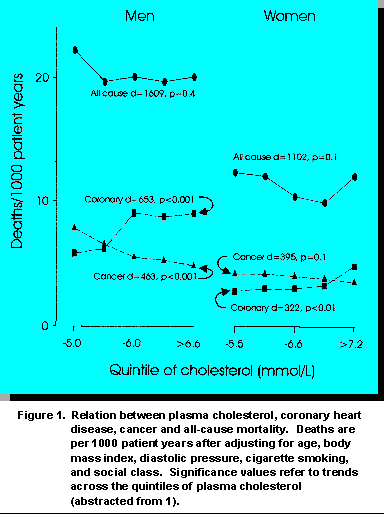
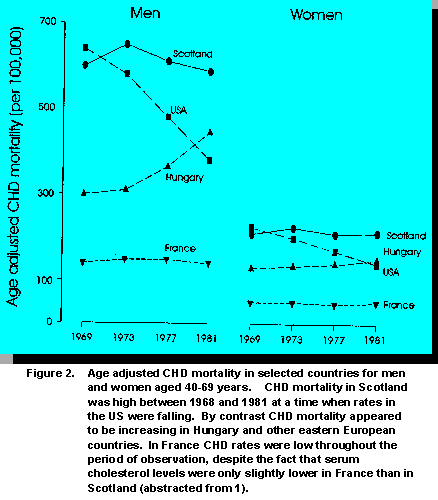
The Framingham group has shown excess CHD risk in men and women with high triglyceride and low HDL irrespective of the total cholesterol level. The French workers, who did not measure HDL, reported excess CHD risk in patients with high triglyceride and normal cholesterol. There is also renewed interest in the possibility that high levels of triglyceride may affect blood coagulation as well as atherogenesis.
For the present, it appears reasonable to conclude that in subjects with high cholesterol, the co-existence of high triglyceride adds little extra risk. In subjects with normal cholesterol, triglyceride > 3 mmol/l may be associated with increased mortality from CHD, particularly if HDL is < 1 mmol/l.
Cholesterol and Cancer
Japan and Heart Disease
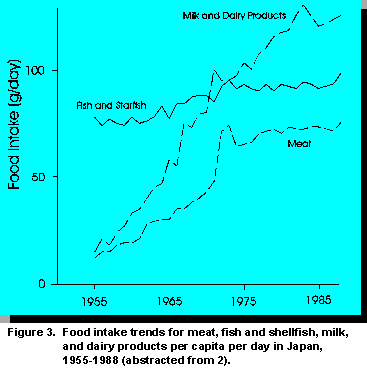
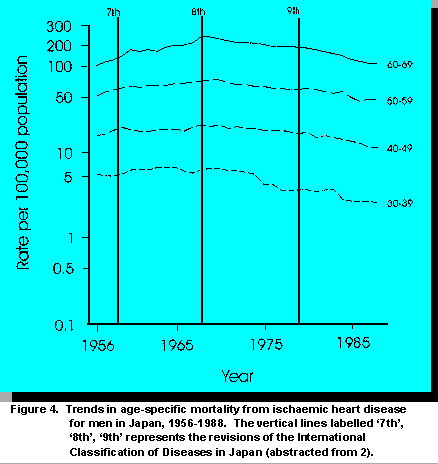
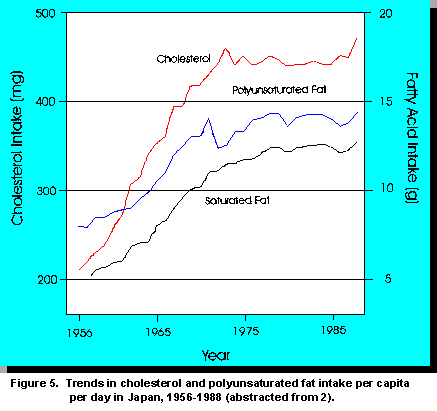
Alteration in dietary fat may modify TXA2/PGI2 balance. Eicosapentaenoic acid 20:5n-3 present in fish oil competes with arachidonic acid at the level of cyclo-oxygenase and inhibits TXA2 and PGI2 formation. It appears that 20:5n-3 is converted to TXA3, a weak pro-aggregating agent with PGI3, a potent anti-aggregating agent. Therefore, the overall effect of fish oil consumption is a decrease in platelet aggregation or increased bleeding time. Since arachidonic acid availability is a key factor in eicosanoid formation, increased attention has been given to synthesis and incorporation of 20:4n-6 into phospholipid pools. N-3 fatty acids, particularly 20:5n-3, are incorporated into plasma and tissue phospholipids at the expense of n-6 fatty acids.
From both animal and human studies it is clear that there is considerable metabolic interaction between the effect of dietary C20 and C22 n-3 fatty acids and the metabolism of 18:2n-6. The efficacy of dietary -3 fatty acid intake is determined in part by the interaction and by the overall balance of dietary fatty acids fed. Thus, one can envisage that potential beneficial metabolic effects of dietary n-3 fatty acids will be optimized by dietary background that is low in competing substrates (i.e. low in polyunsaturated to saturated fatty aids) even though the overall level of n-3 fatty acid intake is relatively low.
Genetic Variance in Responsiveness
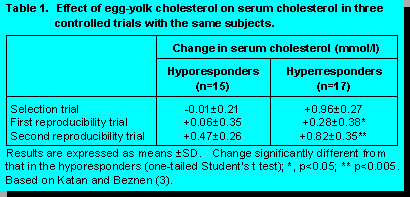 In controlled dietary trials with the same
subjects, studies have been conducted to determine whether individuals exist with a consistently
high or low serum cholesterol response to dietary cholesterol (3). When volunteers successively
consumed a low-cholesterol and a high-cholesterol diet with the cholesterol component of the diets
provided by egg yolk being the only variable, subgroups of putative hyporesponders and
hyperresponding subjects, with mean serum cholesterol increases of 0 and 19%,
respectively, were selected from a larger population. These subjects then underwent a
second and third experiment. Although the response in each subject was only partly
reproducible, selected hyperresponders showed significantly higher serum cholesterol
responses in the second and third trial than the hyporesponders (Table 1).
In controlled dietary trials with the same
subjects, studies have been conducted to determine whether individuals exist with a consistently
high or low serum cholesterol response to dietary cholesterol (3). When volunteers successively
consumed a low-cholesterol and a high-cholesterol diet with the cholesterol component of the diets
provided by egg yolk being the only variable, subgroups of putative hyporesponders and
hyperresponding subjects, with mean serum cholesterol increases of 0 and 19%,
respectively, were selected from a larger population. These subjects then underwent a
second and third experiment. Although the response in each subject was only partly
reproducible, selected hyperresponders showed significantly higher serum cholesterol
responses in the second and third trial than the hyporesponders (Table 1).
Thus it appears that in humans at least part of the cholesterolaemic response to dietary cholesterol is individually determined. It is also clear that some subjects who appear hyperresponsive in one experiment may appear hyporesponsive in another. This is caused by the diet-independent within-person variability of serum cholesterol. Serum cholesterol fluctuates within subjects on a constant diet with a periodicity of two to three days and an amplitude of up to 1.5 mmol/1. Thus the timing of the actual pre- and post-diet change blood samples can be such that the observed response to diet change appears much larger than the actual mean response.
Diet Fat Intake: Palmitic Acid
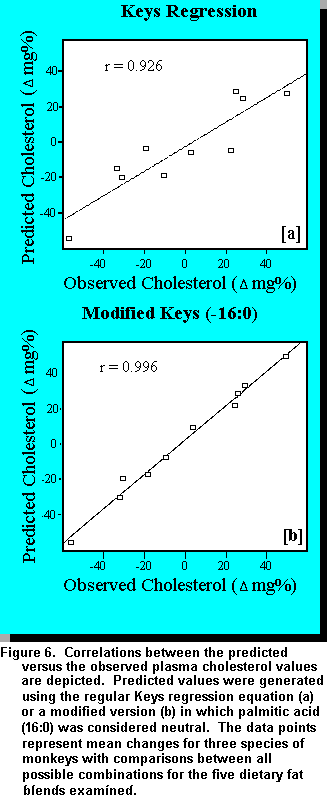 For almost 40 years we have realized that
dietary fat alters the plasma cholesterol concentration, but the degree to which various fats or their
composite fatty acids modulate these effects and the mechanism(s) involved are not well
understood. The situation has been recently complicated because the original findings of Keys and
Hegsted, with particular regard to the effects of specific fatty acids, have been questioned.
Whereas the dietary P/S ratio and intake of total saturated fats were thought to constitute the main
impact, attention is now focused increasingly on the contribution from monounsaturated fats.
Stearic acid has been shown to be neutral in raising serum cholesterol level and when the Keys
equation is modified to treat dietary 16:0 level as neutral, the equation is a better predictor of
observed changes in serum cholesterol levels (Figure 6).
For almost 40 years we have realized that
dietary fat alters the plasma cholesterol concentration, but the degree to which various fats or their
composite fatty acids modulate these effects and the mechanism(s) involved are not well
understood. The situation has been recently complicated because the original findings of Keys and
Hegsted, with particular regard to the effects of specific fatty acids, have been questioned.
Whereas the dietary P/S ratio and intake of total saturated fats were thought to constitute the main
impact, attention is now focused increasingly on the contribution from monounsaturated fats.
Stearic acid has been shown to be neutral in raising serum cholesterol level and when the Keys
equation is modified to treat dietary 16:0 level as neutral, the equation is a better predictor of
observed changes in serum cholesterol levels (Figure 6).
Hayes and Khosla hypothesized that 16:0 is neutral (does not raise cholesterol) relative to 18:1 in normocholesterolemic individuals (< 5.2 mmol/L, 200 mg/dL) and/or when dietary cholesterol intake is low (<= 300 mg/d). In such situations 14:0 appears to be the unique cholesterol-raising fatty acid. To test this hypothesis, a study was designed to exchange 5% of energy from 12:0 + 14:0 for 16:0 in normocholesterolemic human subjects consuming diets containing ~200 mg cholesterol/d (Table 2;4). Subjects were members of the Royal Malaysian Army sequestered in a training camp of the army signal school. The results indicate that a dietary combination of 12:0 and 14:0 combination produces a higher serum cholesterol concentration than does 16:0 in healthy normocholesterolemic young men fed a low-cholesterol diet (Table 3).
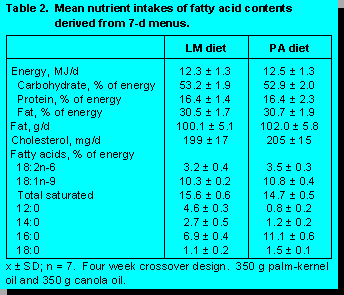
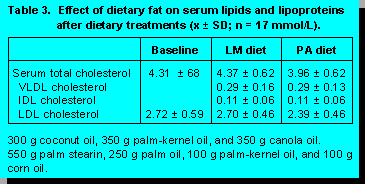
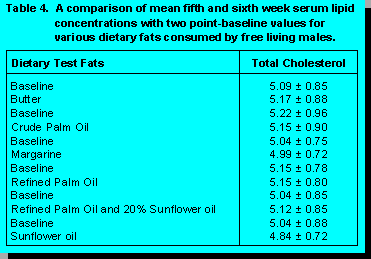
In a recent study by Randall Wood (5), 29 healthy, middle-aged men participated in a study containing six dietary fats. The level of test fat consumed by the participants (18 to 20% of total energy) far exceeded the amount most individuals would consume from a single fat source on any dietary regimen. The extreme levels were used to elicit the largest possible change in serum lipids. Despite the high level of test fats consumed, the responses of serum lipids, lipoproteins, and apolipoproteins were unexpectedly small (Table 4).
The butter diet did not elevate total serum cholesterol or LDL cholesterol significantly relative to either baseline in this group of middle-aged men. The degree of elevation of cholesterol in this study was surprisingly low compared with results with institutionalized subjects or patients on liquid formula diets and approximately one-half the rise above pre- study values for a group of hypercholesterolemic men who consumed 34% of their energy as butter for two weeks. In a similar study to the one described here that contained 38 participants, butter produced a small (5%), but significant rise in the total serum cholesterol and LDL- cholesterol relative to baseline and four other dietary fats.
Palm oil, often proclaimed to be absent from many manufactured foods, did not elevate serum cholesterol, even at these high levels. Palm oil-diet lipoprotein and apolipoprotein profiles were equal to or more desirable than the other test fat (5). The sunflower oil diet, high in polyunsaturated fatty acids, reduced total serum cholesterol the most of any diet, along with reduced LDL-cholesterol and apolipoprotein B. Unfortunately, the desirable HDL-cholesterol and apolipoproteins A1 were also reduced.
Conclusions
References